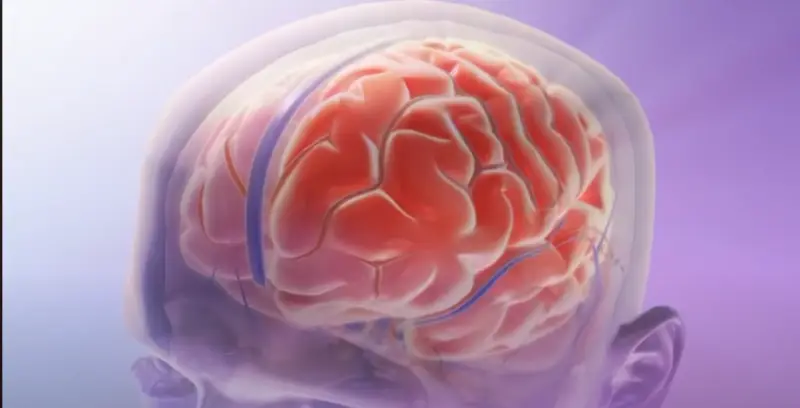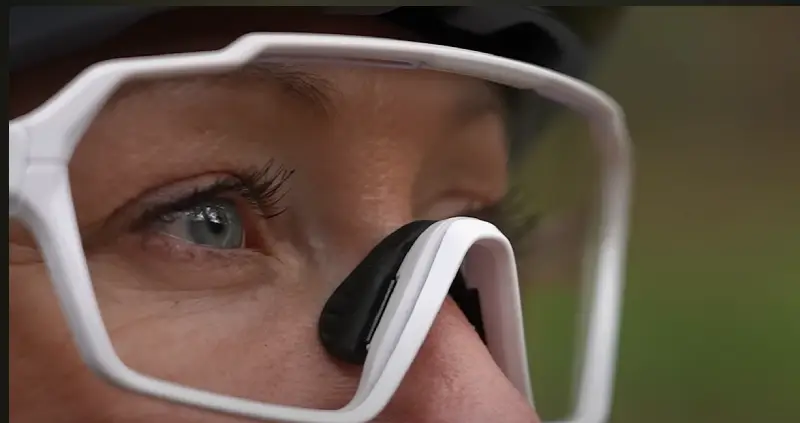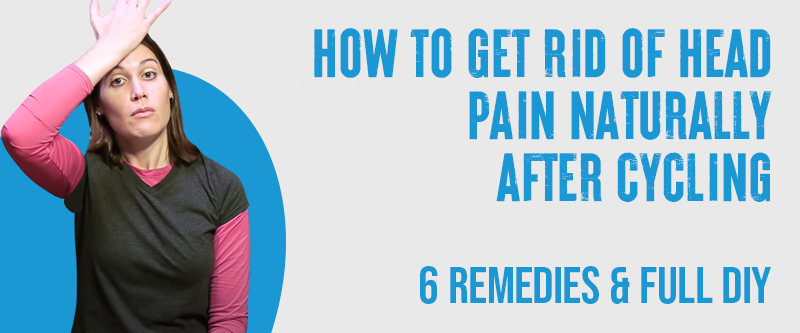Headache pain is caused by signals between the brain, blood vessels, and nerves. Various mechanisms affect blood vessels and muscles during a headache, sending pain signals to the brain.
To get rid of head pain after cycling naturally, take regular breaks to relax tense muscles and do gentle stretches for the neck and shoulders. These practices can help reduce muscle tension that often triggers headaches during or after a ride.
This blog post will explore six natural remedies and two preventative measures to get rid of head pain naturally after cycling.
How To Get Rid Of Head Pain Naturally After Cycling: 6 Tips

Here’s how you can ease post-cycling headaches with natural remedies, from maintaining correct posture to managing light exposure. Check out these natural remedies for reducing headaches after cycling.
Hydration
Hydration is the body’s way of absorbing vital water liquids based on their availability. Every cell, tissue, and organ needs fluid for temperature regulation, waste disposal, and joint lubrication.
Importance of Drinking Water and Replenishing Electrolytes
When you ride your bike, you lose a lot of water through sweat. If you don’t drink enough water, you might get a headache. Water helps keep your body working well and moves important things like electrolytes around your body. Electrolytes are tiny particles that help your muscles and nerves work.
Tips for Staying Hydrated
Stay properly hydrated and eliminate headaches with these day-to-day hydration tips.
Before Cycling:
- Drink an enormous glass of water about an hour before you ride.
- Whenever possible, eat fruits and vegetables with a high water content, like watermelon or cucumbers.
During Cycling:
- Keep a water bottle with you and take small sips regularly.
- If you’re cycling for more than an hour, consider drinks with electrolytes.
After Cycling:
- Drink water right after you finish your ride.
- Have a snack with water and electrolytes, like a banana or a sports drink.
Staying hydrated can help you feel better and avoid headaches after your ride.
Applying Cold Compresses
A cold compress rarely needs to include ice to relieve headaches. Instead, a cold, damp towel can be wrapped around the entire head or the site of pain.
Benefits of cold compress:
Cold compresses are great for helping with headaches after cycling. They can:
- Reduce Inflammation: Cold compresses can make the swollen areas shrink, which helps reduce pain.
- Numb the Pain: The cold feeling can make the pain less sharp, giving you relief.
Apply a Cold Compress to Your Neck or Head
Using a cold compress is simple and effective. Here’s how you can do it:
What You Need:
- A clean cloth or towel
- Ice cubes or a cold gel pack
Steps to Apply a Cold Compress:
- Wrap some ice cubes in the cloth, or prepare your cold gel pack.
- Find a Comfortable Place to Sit or lie down.
Apply to the Affected Area:
- Place the compress on your forehead, temples, or the back of your neck.
- Leave it there for about 15-20 minutes.
Take Breaks:
- If needed, you can repeat this process, but avoid damaging your skin between sessions.
Using cold compresses can help you feel better quickly and naturally after your cycling session.
Warm Bath or Shower
Indulge in a warm bath to alleviate headaches and tension. Elevate your experience by infusing a few drops of lavender or eucalyptus oil for added soothing benefits.
Benefits of Warm Baths for Relaxation and Pain Relief
Warm baths or showers can relieve headaches after cycling. Here’s how:
- Relaxation: Warm water can help you relax, which reduces stress and tension.
- Muscle Pain Relief: It can also help loosen stiff neck and shoulder muscles, which can cause headaches.
Relaxation with Epsom Salts
Epsom salts can make your bath even better. Magnesium in them helps relax muscles and reduce pain.
How to Use Epsom Salts:
- Prepare your bath: Pour warm water into your bathtub.
- Add Epsom Salts: Add about 2 cups of Epsom salts to the water. Stir until they dissolve.
- Soak and Relax: Sit in the bath for about 20 minutes. Let your muscles relax and your headache ease.
Using a warm bath with Epsom salts is a natural way to feel better after cycling.
Proper Bike Fit and Posture

Securing the perfect bike fit and posture is paramount for a smooth and effective cycling journey. Optimal alignment and posture not only boost performance but also serve as a preventive measure against injuries.
Ensure Your Bike Is Fitted Correctly
Having a bike that fits you well is very important. A bad fit can cause neck and back strain, leading to headaches.
Why a Proper Fit Matters:
- Reduces stress on your neck and shoulders.
- It helps you ride more comfortably and efficiently.
How to Check Your Bike Fit:
- Seat Height: Your leg should be almost straight when the pedal is at the bottom.
- Handlebars: They should be level with or slightly lower than the seat.
- Reach: You should be able to reach the handlebars without stretching too much.
Tips for Maintaining Good Posture While Cycling
Good posture while riding helps prevent pain and headaches. Here are some tips:
Keep Your Back Straight:
- Avoid hunching over the handlebars.
- Keep a slight bend in your elbows to absorb shocks.
Relax Your Shoulders:
- Avoid tensing your shoulders.
- Shake them out if they start to feel tight.
Align Your Head:
- Keep your head in line with your spine.
- Avoid looking down for long periods; look ahead on the road.
Following these tips can help you ride comfortably and avoid headaches after cycling.
Stretching and Exercises
Using stretching as a complementary approach alongside other treatments and medical interventions can aid in relieving and preventing headaches. Stretches targeted for headaches help alleviate tension in the upper body and decrease stress levels.
Importance of Stretching Post-Ride
Healthcare professionals believe stretching after cycling is key to avoiding headaches. It helps to:
- Release Tension: Stretching loosens tight muscles that can cause pain.
- Improve Flexibility: Regular stretching keeps your muscles flexible and less prone to injuries.
Recommended Exercises
Here are some easy stretches you can do after your ride:
Chin Tucks:
- How to Do It: Sit or stand up straight. Keep your chin tucked in, and then return to standing.
- Benefits: Helps stretch your neck muscles and improve posture.
Upper Trapezius Stretch:
- How to Do It: Stand up or sit up straight. Gently pull your head to one side using your hand until you feel a stretch in your neck. Hold for a few seconds, then switch sides.
- Benefits: Reduces tension in your neck and shoulders.
Cat-Cow Stretch:
- How to Do It: Bend your knees. Put your back in an arch (like a cat) and hold for a few seconds. Then, dip your back downwards (like a cow) and hold.
- Benefits: Stretches your spine and relieves back tension.
The Management Of Light

Effective light management is key to minimizing headaches and boosting overall well-being. Explore the influence of lighting control on your health for a positive impact.
Using Sunglasses and Helmet Visors
Bright sunlight can cause headaches during and after cycling. Protecting your eyes helps reduce this risk.
Benefits of Sunglasses and Helmet Visors:
- Reducing Glare: Wearing sunglasses or a helmet with a visor can protect your eyes from direct sunlight and glare, which can reduce eyestrain and contribute to headaches.
- Preventing Squinting: Sunglasses help prevent squinting, which can strain the facial and scalp muscles, leading to head pain. By reducing the need to squint, sunglasses or visors can help keep these muscles relaxed.
- Minimizing UV Exposure: Prolonged exposure to UV rays can cause eye fatigue and contribute to headaches. Sunglasses with UV protection help shield your eyes from harmful rays, reducing the risk of UV-induced discomfort.
What to Look For:
- Sunglasses: Choose sunglasses with UV protection and polarized lenses.
- Helmet Visors: Make sure your helmet has a visor, or consider adding one.
Chin Tucks:
- Sunglasses: Choose sunglasses with UV protection and polarized lenses.
- Helmet Visors: Make sure your helmet has a visor, or consider adding one.
Timing Your Rides to Avoid Peak Sunlight Hours
Choosing the right time to ride can also help prevent headaches caused by sunlight.
Why It Matters:
- Heat Reduction: Riding during cooler parts of the day reduces heat stress.
- Less Intense Light: The sun is less intense in the early morning or late afternoon.
Tips for Timing Your Rides:
- Early Morning: Ride before 10 a.m. for cooler temperatures and softer light.
- Late Afternoon: Start your ride after 4 p.m. when the sun’s intensity decreases.
Managing light exposure is a simple way to prevent headaches and enjoy your cycling experience more.
Head Pain After Cycling: 2 Preventative Measures

Properly preparing your body for cycling by warming up, stretching, and staying hydrated can help prevent headaches. Prevent head pain after cycling with these tips. Enhance your biking experience and stay headache-free. Prioritize well-being for a smooth ride every time.
Warming Up Before and Cooling Down After Cycling
Effectively conditioning your body before and after cycling can help mitigate headaches.
Warm-Up:
- Why It’s Important: Warming up gets your muscles ready and increases blood flow.
- How to Do It: Spend 5-10 minutes doing light exercises like jogging or dynamic stretches.
Cool Down:
- Why It’s Important: Cooling down helps your body return to normal and reduces muscle stiffness.
- How to Do It: After your ride, spend 5-10 minutes doing gentle stretching or slow cycling.
Gradually Increasing Ride Intensity and Duration
Building up your endurance slowly can help you avoid overexertion, which can lead to headaches.
Why It Matters:
- Prevents Overexertion: Gradual increases allow your body to adapt without being overexerted.
- Builds Stamina: Helps improve your overall fitness and cycling performance.
How to Do It:
- Start with shorter, easier rides and gradually increase the distance and intensity.
- Listen to your body and take breaks when needed.
Conclusion
Dear fellow cyclists, we’ve explored the causes, methods, and remedies for those pesky post-cycling headaches.
Our exploration found natural remedies like staying hydrated, using cold compresses, taking relaxing baths, adjusting bike fit, doing beneficial stretches, and controlling light exposure. Remember to warm up before and cool down after your ride.
Stay calm when building endurance. These simple strategies can help you enjoy cycling without headaches and keep the thrill of your cycling adventures alive.
FAQs
What Causes Headaches In The Back Of The Head?
Tension headaches, often the primary source of pain at the back of the head, can persist for 30 minutes to a week. These headaches are typically triggered by intense stress, fatigue, inadequate sleep, missed meals, improper posture, or insufficient hydration.
What’s The Right Amount Of Sleep To Prevent Headaches?
Adults should sleep at least seven hours a night to avoid headaches. This range supports well-being and reduces headache risks. Sleeping less than 7 hours or over 9 hours may trigger headaches. Maintaining a regular sleep schedule and a sleep-friendly environment can also help prevent headaches.


